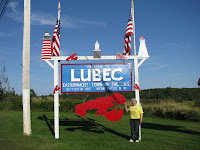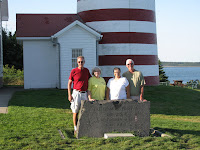Getting the RV through the U.S. Customs booth became the most difficult part of crossing the border. Like the old crossing at Vancouver, B.C., RVs are directed to the leftmost booth. To get there requires a 45 degree right turn followed by a 90 degree left turn into a lane with cement poles bordering each side. It can be done, but only very carefully. Whoever designed these lanes knows nothing about maneuvering in a large RV. Derrille got a standing ovation when we went through in B.C. Here, he told the inspectors he didn't want to use that lane, and they let us go through the straight on lane. Normal traffic backs up into downtown St. Stephens, so you can only imagine what happened when two big RVs slow the process even more. They did come in and took my tomatoes. I had the cat info ready, but again they didn't care.
Although Calais ( "Ca lay" in French, a soft lovely sound. It's "callous" when said by the locals...ick!) looked like a depressed economic area we found these beautiful homes along Highway 1.
We still get excited to see this architecture. Maybe that will wear off as we continue through the northeast.
Although Calais ( "Ca lay" in French, a soft lovely sound. It's "callous" when said by the locals...ick!) looked like a depressed economic area we found these beautiful homes along Highway 1.
We still get excited to see this architecture. Maybe that will wear off as we continue through the northeast.
So we passed right through and into the town of Calais. Calais had the Wal-mart for photos, the grocery store and a place for dinner. We followed Highway 1 from Calais to the turn off for Highway 190 that leads to Eastport.
The road passes through the Passamaquoddy Reservation. Then a causeway takes you to Moose Island and Eastport. Our first impression of Seaview RV raised doubts about my choice of parks, but the site turned out to be level and we looked at the water. Lovely! A short drive up the island takes you to the Roosevelt summer home. James and Sara Roosevelt brought their one year old son Franklin to the island in 1883. At that time the island was a retreat for the well-to-do of Canada and America. James and Sara bought a cottage and spent most every summer there. A neighbor offered Sara the cottage next door for $5000 and she bought it in 1905. That became the place that Franklin and his family used. He even added a wing in 1915 to meet the needs of his growing family. Sara willed the house to Franklin. Franklin and Eleanor's third son was born here. The family enjoyed sailing, rowing, canoes, fishing, hiking, tennis, horseback riding and picnics to name a few of the summer activities.
Nearly every summer between 1833 and 1921 were spent here. When Franklin contracted polio in 1921 visits were fewer. James and Sara's cottage no longer exists, but the other cottage is open to the public and with NO FEES! Guides stationed throughout the 34 room, fully furnished cottage share information and answer questions about the house and the family. I especially enjoyed the many colorful flower beds around the house.
A row of just Dahlias, some with a 10-12 inch diameter, stood tall in the sun. Other "cottages" can also be visited.
Lunch time! The island only has two restaurants. We chose the one at Herring Cove Golf Course. From there we drove north through the various harbors and cove up to the East Quoddy Lighthouse at Harbor Head.
During low tide visitors use metal stairs to cross the sea floor and access the island. The tide was high during our visit.
Not far from the lighthouse round pens of Atlantic salmon sit out in the bay. The man in the trailer next to us works one of the boats that haul feed for the pens. He said the fish are fed pellet that come in various sizes depending on the size of the fish.
We completed the loop back to the bridge and the Campobello lighthouse to took a look around Lubec, ME. Atlantic Herring supplied the livelihood for Lubec, which used to be many times bigger than what we saw. It claims to have the last commercial herring smokehouse. Lubec maintains that quaint harbor look.
The banners on the light posts state that Lubec is the easternmost town in the United States. The sun rises first here on the continental United States. Lynn and I will remember it as the home of Monica's Chocolates. YUM! We loved the Anne of Green Gables chocolate on PEI and this tasted even better.
Just a bit out of Lubec a left turns takes you to the red and white striped West Quoddy Lighthouse. We took photo ops here.
A young lady traveling alone to our foursome shot. We took her photo for her. Of course she went home with a couple of shots that included Jay and Derrille with her. Can't you hear people asking, "Who are those guys?" to which she answers a couple of fun loving guys I met at the lighthouse. At least we hope that might be her response.
Eastport shows its age in the vintage homes, many in need of maintenance. North-south streets lead to the harbor by Main Street. Narrow cross streets follow the contour of the hill. We found a large freighter being loaded at a harbor on the back of the hill. This industrial area looked very different from the fishing boat harbor downtown. Driving around town, we noted that Eastport was much larger than expected. We could tell that in prior times fishing and shipping made this a busy place. The current population claimed about 2,000 people, but in earlier times the population exceeded 5,000 people.
The day we explored Eastport a small Farmer's Market appeared near downtown and we checked it out. Main Street runs right in front of the fishing harbor.
Whale watching boats, fishing boats, sailboats, and ferries use this busy harbor. Lynn and I visited the cute shops.
 The hardware store displayed books written by Sarah Graves. She writes murder mystery books with a remodeling theme. Sarah and her husband came to Eastport and remodeled an old Victorian house on the hill. They have become permanent residents. I enjoyed her first book, especially knowing the places she writes about. So I went back and bought the whole set. She has signed each book. It is light reading, and not as polished as some writers (yet), but I enjoy her stories.
The hardware store displayed books written by Sarah Graves. She writes murder mystery books with a remodeling theme. Sarah and her husband came to Eastport and remodeled an old Victorian house on the hill. They have become permanent residents. I enjoyed her first book, especially knowing the places she writes about. So I went back and bought the whole set. She has signed each book. It is light reading, and not as polished as some writers (yet), but I enjoy her stories.  We chuckled over the banner. Lubec claims to be the easternmost "town", while Eastport claims to be the easternmost "city". The fisherman statue sits in front of the harbor.
We chuckled over the banner. Lubec claims to be the easternmost "town", while Eastport claims to be the easternmost "city". The fisherman statue sits in front of the harbor.One day we decided to take the Eastport ferry to Deer Island, which is part of New Brunswick.
The ferry runs on the hour and to our surprise was a two-piece ferry.....a car barge pushed by a tugboat.
Crossing the water reminded us of trips through the San Juans. We watched a porpoise play in the water, saw some seals, an eagle and the usual array of water birds. Deer Island, established in 1770, is ten miles long and three miles wide. One hundred people and the deer live here. Custom officials meet the boat and check passports before letting you off the boat. After disembarking from the ferry the road goes to the right or left curving around each side of the island and meeting again at the ferry to St. George, New Brunswick.
The ferry to St. George is similar to the ones we took in Nova Scotia to the two little islands. The ferry beeps when people are to load. On all of the little ferry boats we have taken, a worker collects the money after you board.
We drove through St. George and then followed the road down that finger of land to the tip and the city of St. Andrew. Listed as a resort destination for the well-to-do in the 1800 and 1900s, St. Andrew continues to be a destination of choice. A grand hotel sits high on the hill overlooking the bay, coves, inlets, harbors and beaches around St. Andrew. As we drove by the green manicured lawn included a white canopied covered area, white skirted tables, and an array of chairs obviously awaiting the bride. Many B & B's, inns and motels offered lodging as well as a lovely RV park near the water.
We continued looping around the peninsula. The road brought us back to St. Stephen. Instead of taking the border crossing in downtown, we stayed on the freeway that skirted around St. Stephen. The freeway ended at a new wide, modern customs stations. This is where the truckers cross. The lanes are wide and easy to access. From St. Stephen you enter Calais from the north and in downtown. From the freeway you enter Calais south of downtown.
Between Calais and Eastport a roadside pull-out marks the 45th parallel. We noted similar markers in Salem, Oregon and Halifax, Nova Scotia. The reader board describes the mechanics of sighting the latitude mark.
We found it interesting that this eastern edge of Maine runs on the same geographical line as Salem, OR. That places Washington and the top of Maine at about the same latitudinal line...I think.

 Someone really got into creating these stick people. They stand on both sides of the road. One set of figures even sets on a bit of grass next to the cove.
Someone really got into creating these stick people. They stand on both sides of the road. One set of figures even sets on a bit of grass next to the cove.Our days in Eastport turned out to be very interesting.
Next Stop: Bar Harbor
























































No comments:
Post a Comment